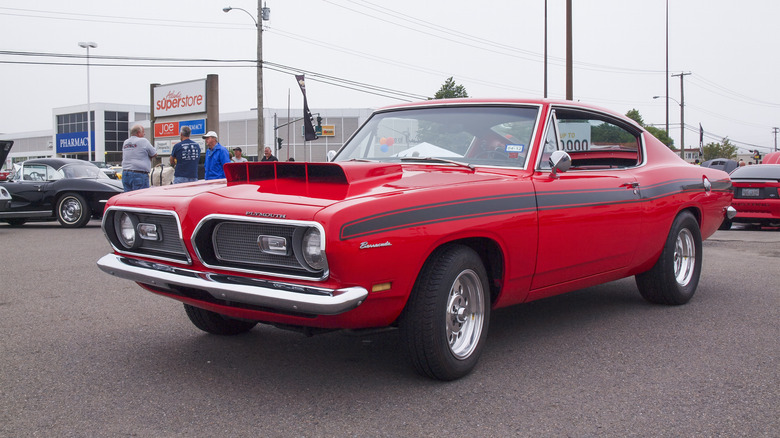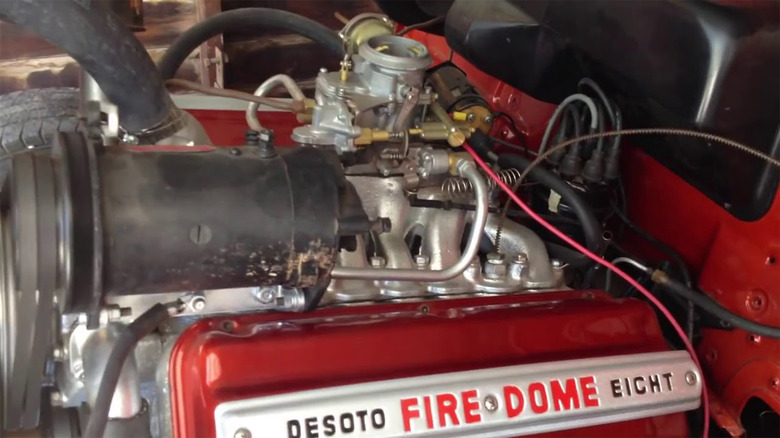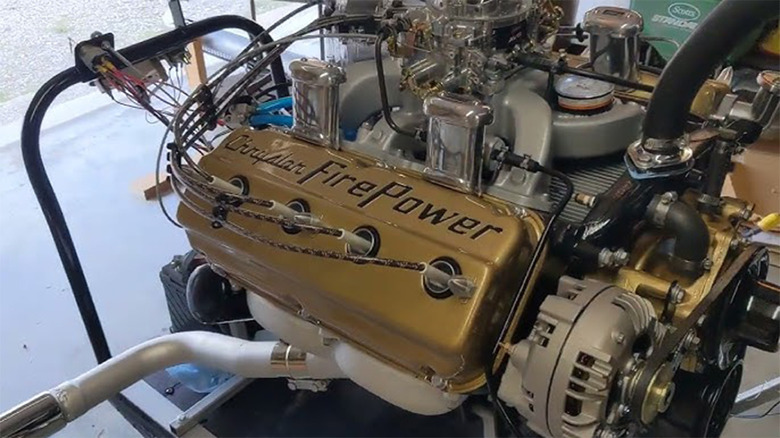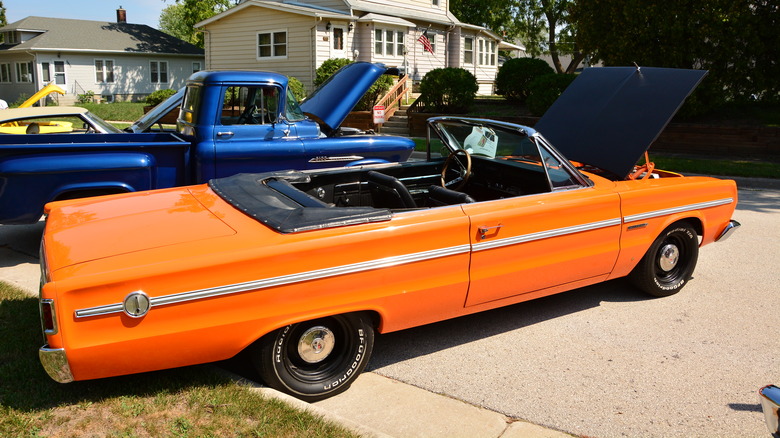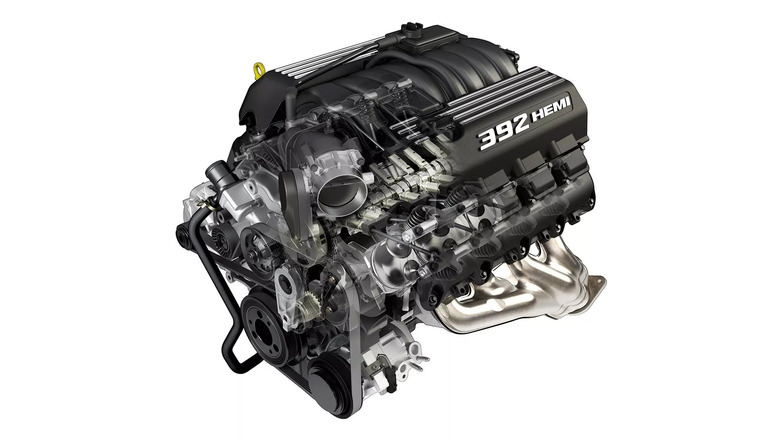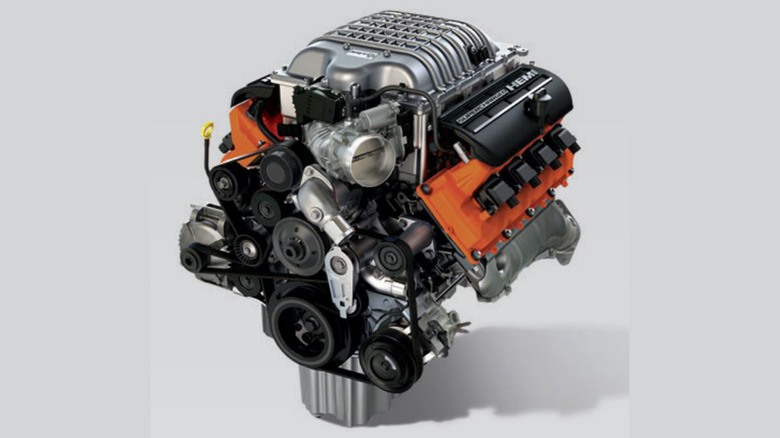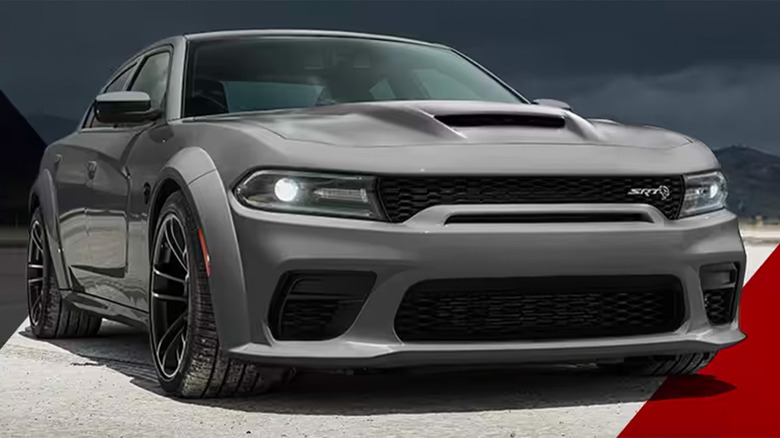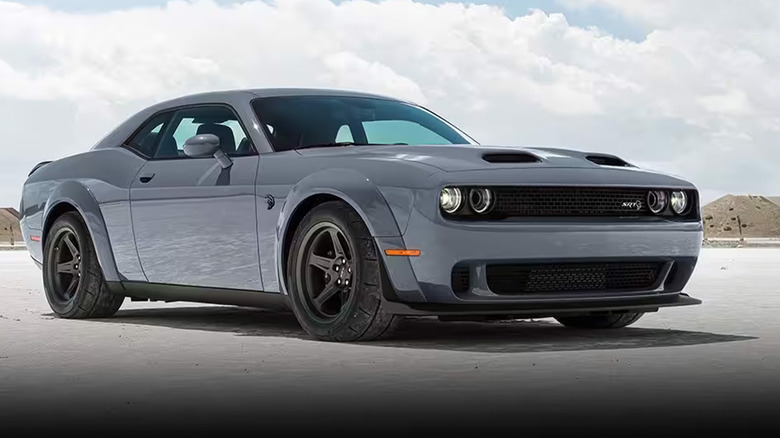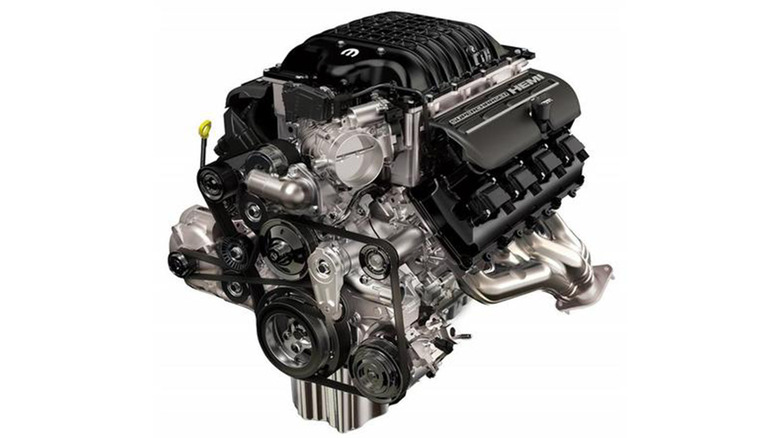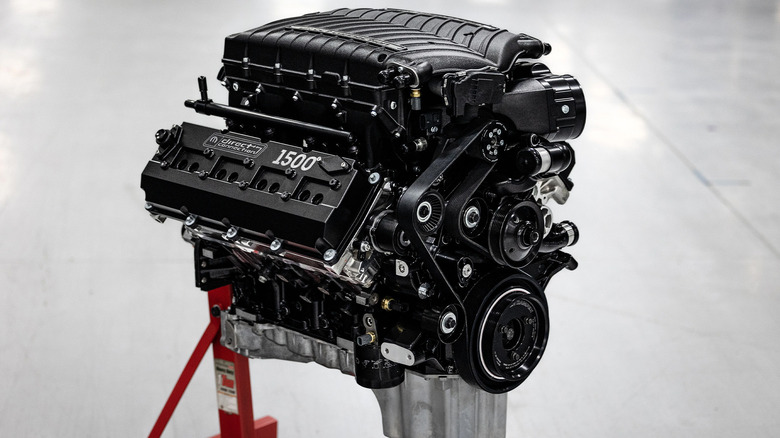Every Major Hemi Engine Ranked, Least To Most Horsepower
The Chrysler Hemi engine has a rich history. The automaker didn't initially put Hemi engines into cars. Originally, they were produced for military and aeronautic use. Thus, while many folks were expecting to see a car of some sort at the beginning of the Hemi engine's history, it was, in fact, the M47 Patton tank and the P-47 Republic Thunderbolt fighter aircraft that got first dibs on what would eventually become an American muscle car classic. After the war, Chrysler used the knowledge obtained to create car engines. It released its first Hemi engine in 1951.
The Hemi wouldn't gain fame until the 1960s, alongside the excellent Chrysler Slant Six when it started showing up in muscle cars. Particularly, the 426 cubic inch Elephant engine that showed up in the Plymouth Belvedere, Dodge Dart, Plymouth Fure, and Dodge Coronet models in the mid-1960s. From there, the Hemi brand became known for being unapologetically powerful, with increasingly ridiculous engines, some of which are still used today. It's not uncommon to see Hemis banned from competitions like they were with NASCAR back in the mid-1960s.
So, here are some of the most powerful Chrysler Hemi engines ever made. Chrysler is part of Stellantis, which also owns Dodge, Jeep, Ram, Fiat, and others. Additionally, Dodge and Chrysler merged back in 1928. Thus, while these engines have Chrysler's fingerprints on them, don't be shocked if you see plenty of references to Plymouth, Dodge, Ram, Jeep, and the other brands under the umbrella. Even DeSoto played a role in the Hemi legacy, even if it was just at the beginning.
9. DeSoto Firedome Hemi (345 HP)
DeSoto played a big role in the development of the early Chrysler Hemi engines. DeSoto was part of the Dodge Chrysler umbrella alongside Plymouth and other brands. While the brand was eventually phased out, it hit its stride in the 1950s. Part of that success is attributed to the DeSoto FireDome Hemi, which launched alongside the Chrysler Firepower Hemi around the same time. It's one of the first Hemi engines ever produced and DeSoto made a few of them in the 1950s. By decade's end, the DeSoto FireDome Hemi had achieved a maximum of 345 horsepower.
The 345 cubic-inch engine was about as raucous as it could be for the era, producing one horsepower per cubic inch of displacement. It was put into the 1957 DeSoto Adventurer, which was the most powerful car DeSoto ever made. There isn't a lot of performance data available for the Adventurer, but some measurements have it doing zero to 60 MPH in 7.2 seconds and zero to 100 MPH in 22.2 seconds. Those seem rather pedestrian compared to today's vehicles, but back in the 1950s, it was pretty quick.
Unfortunately, DeSoto wasn't long for the world, despite its success in 1957. A recession took out some of the brand's sales while Chrysler and Dodge started heading in another direction with its brand lineup. DeSoto would hold one for another few years, but ultimately kicked the bucket after the 1961 model year. Its success was brief but for a while, DeSoto had one of the strongest engines ever put into a car.
8. Chrysler FirePower Hemi (390 HP)
The Chrysler FirePower Hemi was the first Hemi engine that Chrysler designed for car use. It debuted in 1951 and was used primarily in Chrysler vehicles, including the Saratoga, New Yorker, and Imperial. Today, most articles and videos where people are modifying or restoring an old 331 pulled them from an Imperial, but it was an engine that Chrysler used frequently through 1955. In 1956, the 331 grew into the 354, and with it came higher power numbers. Eventually, it wound up being a 392 cubic-inch engine.
So, let's break all these down. In the beginning, the 331 cubic inch variant of the FirePower supplied a modest 180 horsepower and was used by Chrysler through 1955. In 1956, Chrysler increased the displacement to 354 cubic inches, which increased the power to 350 horsepower. When the final iteration came out in 1958, it had grown to 392 cubic inches and had 390 horsepower. The 392 would be short-lived, however, as Chrysler turned to a different engine architecture in 1959, which ended the first generation of the Chrysler Hemi engine.
As per Motortrend, Chrysler moved away from the FirePower Hemi engines due to issues with size and its cost to produce. It was one of the most complex engines of its era, and Chrysler had legitimate difficulty fitting the thing into cars. Fortunately, some enthusiasts still enjoy modifying the FirePower to this day. Some folks have modded a 331 to produce as much as 425 horsepower (estimated), so there were still some secrets left to unlock even in Chrysler's oldest Hemi engine.
7. Chrysler 426 Hemi V8 (425 HP)
Chrysler began hitting its stride with the legendary Chrysler 426 Hemi V8. It was part of the American muscle car era in a pretty big way and earned some accolades and notoriety during its lifespan. The engine was originally built for NASCAR racing, which Chrysler paired with the 1964 Plymouth Belvedere. However, the engine was banned in 1965 after competitors complained that it gave its drivers an unfair advantage. It was a fair complaint as 426-powered cars took the first four spots at the Daytona 500 in 1964. Chrysler responded by making a less powerful version for 1966 that was then allowed back onto the NASCAR circuit.
The street version of the 426 cubic inch engine could reach 425 horsepower at the peak of its power. It featured a lower compression ratio than the race version of the engine at 10.25:1 instead of 12.5:1 and also housed a different camshaft, intake, and exhaust manifold. The heads were also iron instead of aluminum like they were on the race engine. Word around the water cooler is that Chrysler fudged the numbers, and they might have been higher.
The engine popped up in several cars in the 1960s and early 1970s, including the Dodge Dart, Dodge Coronet, Plymouth Fury, and Plymouth Belvedere. It eventually left production in the 1970s due to Chrysler and Dodge's greatest nemesis: federal emissions standards. After the engine left production, enterprising racers eventually modified the engine, giving it new life on the drag race scene for many years.
6. Chrysler 392 Hemi SRT (485-525 HP)
The Chrysler 392 Hemi SRT is one of Chrysler's more recent engines. Also known as the Apache, the engine is part of the third generation of Hemi engines that started production in 2003. It was modified from a similar 5.7-liter Hemi, known as the Eagle. The Apache was first put into service in 2007. It most recently powered the 2023 Chrysler 300C but has been housed in several Dodge and Chrysler vehicles over the years. It also featured a cylinder deactivation function that helped it be more fuel efficient and friendlier to emissions regulations.
The 6.4-liter engine boasts between 485 and 525 horsepower depending on the generation and application. The 525-horsepower variant also boasts 510 pound-feet of torque, making it a strong engine overall. It achieves those numbers with a forged steel crankshaft and a 10.9:1 compression ratio. However, most of the engine is made of forged steel or aluminum to withstand its power. Several variations are slightly different given its age and nearly two decades of service.
In terms of vehicles, Dodge and Chrysler put this engine into a few of its biggest cars, including the Dodge Charger SRT, Dodge Challenger R/T Scat Pack, Jeep Grand Cherokee SRT, and the Chrysler 300C. Its smaller sibling, the 5.7-liter V8, is used in current Ram trucks and has found a home in the Dodge eTorque hybrid system. Even so, the 6.3-liter variant is just a tad stronger, stretching up over 500 horsepower while the 5.7-liter sibling doesn't, so it's the version we're going with here.
5. Dodge Hellcat 6.2-liter Hemi V8 (717 HP)
Now it's time to get into the meat and potatoes of the Chrysler and Dodge Hemi lineup. The Hellcat 6.2-liter Hemi V8 is an engine among engines in that it's supremely powerful and hilariously fun. It's one of the largest engines ever put into a production vehicle. When it was used in the 2015 Dodge Challenger SRT coupe, Dodge referred to it as the most powerful muscle car ever made. Later, it was used in the Ram 1500 TRX, which was, at that time, the most powerful production truck ever assembled.
So, what makes the Hellcat so special? Well, for starters, it pumps out over 700 horsepower. The original variant in 2015 offered 707 horsepower and 650 pound-feet of torque. In 2019, the engine was revamped slightly to bump those numbers to 717 horsepower and 656 pound-feet of torque. The engine was extremely quick, propelling Dodge's heavy muscle cars from zero to 60 MPH in 4.1 seconds with a quarter mile time of 1.8 seconds at 124 MPH. Even in a truck, the engine impressed, recording a zero to 60 time of 4.5 seconds and a 12.9-second quarter mile.
Unfortunately, Dodge and Chrysler put this engine out to pasture in 2023 thanks to, you guessed it, federal emissions standards. However, that didn't stop the muscle car titans from releasing a few more cars with even more absurd horsepower numbers, which we'll get into later. The Hellcat 6.2-liter V8 was a huge deal in the Dodge and Chrysler lineup, and it was even the basis for some of the other engines further down the list.
4. Dodge Supercharged Hemi V8 Demon (840 HP)
One such engine that was based on the Hellcat was the original Demon engine. This monster of an engine took everything that made the Hellcat great and dialed it up even further. According to Dodge lore, the Demon is a Hellcat engine with nearly 100 modifications, including a different supercharger with more boost pressure along with a different crankshaft, connecting rods, pistons, camshaft, and valvetrain. The resulting engine has the same DNA, but as we'll discuss in a moment, it was a completely different beast.
Dodge put this into one car named after the engine, the 2018 Dodge Challenger SRT Demon. This monster boasted 840 horsepower, 770 pound-feet of torque, and some impressive chops. The only caveat with the engine is that you needed race fuel to hit its 840 horsepower number. With 91 octane gas, the power numbers would reduce slightly to 808 horsepower. In any case, the car and engine were very fast, clocking a zero to 60 time of 2.1 seconds on a treated drag strip. The engine has also been made available in limited quantities as a crate engine for use in drag racing.
When the 2018 Challenger SRT Demon launched, it was NHRA-certified as having the fastest quarter-mile time of any production car in the world and was faster than the V10 Dodge Viper. Dodge would outdo itself a few years later with even stronger engines, but the Dodge SRT Demon had its time in the limelight. Somewhat comically, the NHRA banned this car from drag racing almost immediately after its release despite being the organization that certified it in the first place. Fortunately, this monster is still street-legal, so it can be driven on regular roads.
3. Dodge Hellcat 6.2-liter V8 D170 (1,025 HP)
The Dodge Hellcat 6.2-liter V8 D170 is a special engine because it is, to date, the strongest engine that Dodge or Chrysler have ever put into a production vehicle. Everything after this are crate engines designed for drag racing. The car this was put into is the 2023 Dodge Challenger SRT Demon 170, which is named for the engine, and it is one of the wildest cars to ever exist. It is, as of its release, the fastest production car to ever exist. It was part of Dodge's Last Call series before they discontinued the gas-powered Challenger and turned it into an EV like the Mustang Mach-E.
So, let's get to the brass tacks. The engine makes an incredible 1,025 horsepower and 945 pound-feet of torque. It boasts a zero to 60 MPH time of 1.66 seconds and an NHRA-certified quarter mile of 8.91 seconds with a speed of 151.17 MPH. It accelerates so quickly that it produces two Gs of force on the driver. Every one of those stats is a world record for a production car. As the final car in Dodge's Last Call promotion, the car costs $96,666, with the triple sixes being an obvious nod to the car and engine.
Now, there are some caveats. The engine only gets its rated horsepower on a 170-proof ethanol gas mixture, also known as E85. It can take regular gas, but it does lower the horsepower to 900 and the torque to 810 pound-feet. That's still higher than the 800-horsepower Demon from 2018. This is a special engine and a special car. While the Challenger will ride off into the EV-powered sunset, this special engine will remain available as the Hellephant C170 Hemi crate engine for drag race enthusiasts.
2. Dodge Direct Connection 7.0-liter V8 Hellephant A30 and A170 (Up to 1,100 HP)
Dodge Direct Connection 7.0-liter V8 Hellephant A30, which is also known as the 426 Supercharged Crate Hemi, and A170 are two of the most powerful crate engines that money can buy. The first, the A30, has been sold off and on since 2018, with its most recent offering being in mid-2023. It's a 426 cubic inch, all-aluminum engine with a 3.0-liter IHI supercharger and several upgrades from the engine it's based on, which is the Hellcat Redeye engine. All told, it makes 1,000 horsepower and 950 pound-feet of torque. The fact that it's designed to do it on 93-octane gas instead of E85 makes that number all the more impressive.
However, if you decide to go with the E85 version of this engine, you'll be looking at the A170 model. It's specifically designed for E85 use, and the more combustible fuel grants it more than 1,100 horsepower, according to Dodge. Unfortunately, those numbers are estimates right now because the A170 hasn't officially been launched as of this writing. It's scheduled to come out sometime in mid-2024. Other than its thirst for E85, it's virtually the same engine as the A30, up to and including its aluminum construction and forged steel components.
These engines are crate engines, so they were never launched in a production car by Chrysler or Dodge. These engines are designed for drag race use. You buy one, pop it into your car, and then drive it. Dodge posts disclaimers on the product pages of these engines that warn people against driving cars with these on the road due to local and federal emissions laws. Driving a car with one of these engines on the street is legal if it was manufactured before 1976.
1. Dodge Direct Connection 1500 Hemi (1,500 HP)
Everything that Dodge and Chrysler have done over the years has culminated in this monstrosity of an engine. It boasts a truly incredible 1,500 horsepower and 1,000 pound-feet of torque, making it the most powerful engine that Dodge and Chrysler have ever made. As of this writing, it's the most powerful crate engine ever produced by an American automaker. Like its other 170 brethren, this Hemi requires E85 gas to get its full horsepower numbers. It is unable to accept any other kind of gas.
So, how did Dodge and Chrysler do it? Well, the 7.0-liter engine block is cast iron while most of the rest of the components are billet steel and billet aluminum. It has 426 cubic inches of displacement, which means it's related to all of the engines on the second half of this list. It also has an RPM maximum of 7000, which is higher than most of the other engines on the list. In short, it's incredibly powerful, can rev itself out, and it's made of some seriously high-strength components.
The engine hasn't officially launched yet, but Dodge and Chrysler have licensed the engine out to Dan Schumacher Racing (DSR), and the company is selling the engine directly. It's only available for pre-order as of this writing, but the engine will set you back $59,990. In fairness to the engine, it does cost less than the Dodge Challenger SRT Demon 170 above by about $30,000. However, if you want the biggest horsepower numbers, you'll have to pay for it.
